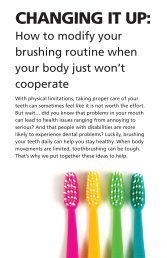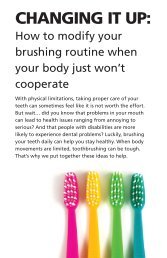Thirsty for Health Toolkit
You also want an ePaper? Increase the reach of your titles
YUMPU automatically turns print PDFs into web optimized ePapers that Google loves.
Background<br />
Water Access is Critical <strong>for</strong> Students’ <strong>Health</strong><br />
Students must be healthy to do well in school, and keeping kids hydrated helps make this possible.<br />
Since 2016, Oral <strong>Health</strong> Kansas has engaged school districts across Kansas to improve access to and<br />
consumption of water <strong>for</strong> students in grades K-12. The <strong>Thirsty</strong> <strong>for</strong> <strong>Health</strong> model increases healthy<br />
behaviors through policy and practice changes in schools to improve the accessibility of drinking<br />
water throughout the school day. This program was built on approaches recommended by the<br />
Centers <strong>for</strong> Disease Control and Prevention (CDC), American Academy of Pediatrics (AAP), and<br />
National Policy and Legal Analysis Network to Prevent Childhood Obesity (NPLAN). When schools<br />
provide drinking water as an alternative to sugar-sweetened beverages (SSBs) such as soda, fruit<br />
drinks, and sports drinks, they promote students’ overall health and development. Encouraging<br />
consumption of water, especially in place of SSBs, can help limit excess weight gain and prevent<br />
dental disease, including cavities. Drinking water also helps students stay hydrated, focused, and<br />
ready to learn.<br />
The main components of <strong>Thirsty</strong> <strong>for</strong> <strong>Health</strong> are:<br />
Recruitment of key stakeholders such as school nurses, teachers, administrators and community<br />
partners<br />
Conducting policy and needs assessments with districts or individual schools<br />
Creating school action plans to increase access to and improve the delivery of water in school<br />
buildings by updating and modifying water access points<br />
Sharing policy options <strong>for</strong> school districts to adopt<br />
Providing teachers and staff with educational resources to teach students about the importance<br />
of drinking water and staying hydrated<br />
Surveying students about their beverage preferences and tracking changes in their behavior<br />
Engaging students in discussions about the importance of drinking more water<br />
Promoting water as a fun, healthy choice through a social media campaign<br />
The strategic goals of <strong>Thirsty</strong> <strong>for</strong> <strong>Health</strong> are:<br />
1. Build a dedicated team of stakeholders committed to improving water access and consumption<br />
2. Select a water delivery option that is appealing to students<br />
3. Encourage students to drink water using promotional and educational activities<br />
4. Implement model water-related language in your school’s wellness policy<br />
5. Secure local funding <strong>for</strong> activities and building modifications<br />
6. Evaluate your program and make improvements<br />
Oral <strong>Health</strong> Kansas <strong>Thirsty</strong> <strong>for</strong> <strong>Health</strong> <strong>Toolkit</strong> 3








